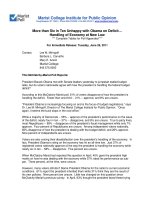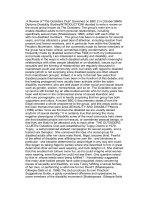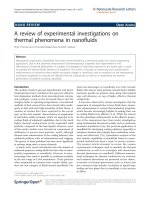Investigations on Haemato-biochemical alterations in buffaloes affected with gastrointestinal tract atony
Bạn đang xem bản rút gọn của tài liệu. Xem và tải ngay bản đầy đủ của tài liệu tại đây (219.22 KB, 7 trang )
Int.J.Curr.Microbiol.App.Sci (2019) 8(3): 7-13
International Journal of Current Microbiology and Applied Sciences
ISSN: 2319-7706 Volume 8 Number 03 (2019)
Journal homepage:
Original Research Article
/>
Investigations on Haemato-biochemical Alterations in Buffaloes Affected
with Gastrointestinal Tract Atony
Jubin*, Yudhbir Singh, V.K. Jain and Neelam
Department of Veterinary Medicine, Lala Lajpat Rai University of Veterinary and Animal
Sciences, Hisar - 125004, Haryana, India
*Corresponding author
ABSTRACT
Keywords
Buffaloes,
Haematobiochemical,
Gastrointestinal
tract, Atony
Article Info
Accepted:
04 February 2019
Available Online:
10 March 2019
The present study was planned to investigate haemato-biochemical alterations in
buffaloes affected with gastrointestinal tract atony. The study was carried out in 50
clinical cases of non-traumatic, primary gastrointestinal tract atony in buffaloes. Eight
apparently healthy buffaloes were included in the study which constituted the control
group. Haematological alterations in buffaloes affected with atony of gastrointestinal
tract revealed significant higher total leucocyte count, neutrophils and significantly
lower lymphocytes than the apparently healthy buffaloes. The diseased buffaloes had
significantly higher level of serum aspartate aminotransferase, total bilirubin, glucose,
creatinine and total proteins levels along with significantly lower serum calcium,
potassium and chloride levels than the buffaloes of control group. The present data
may be utilized for suggesting therapeutic regimen for the treatment of animals
affected with gastrointestinal tract atony.
mucosa. Normal reticulo-ruminal contraction
is very much essential for proper digestion.
Any deviation from these procedure lead to
indigestion, which is followed by a common
set of symptoms known as gastrointestinal
motility disorders. Abnormalities of stomach
and intestinal motility represent the most
common consequence of gastrointestinal tract
diseases. Disruption in gastrointestinal tract
motility can result in hypermotility or atony,
distension of segments of the tract, abdominal
pain, dehydration and shock, out of which
atony in gastrointestinal tract is commonest
appetance
to
anorexia,
dehydration,
constipation, scanty or absence of feces,
Introduction
Productivity of dairy animals depends not only
on good nutritious diet but also on its proper
digestion and assimilation. An efficient
digestive system is vital to an animal not only
for its physical outlook but also to produce
milk and meat (Walia et al., 2011). Being a
ruminant, forestomach of buffalo has complex
set of physiological and biochemical
procedures to digest carbohydrate to produce
volatile fatty acids. Subsequently these
volatile fatty acids are absorbed by ruminal
one (Radostits et al., 2006). Common
symptoms of gastrointestinal tract atony are in
7
Int.J.Curr.Microbiol.App.Sci (2019) 8(3): 7-13
recurrent tympany, loss of production and
body condition, suspended rumination,
reduced or absence of ruminal motility, colic
signs, sometimes fever etc. which not only
affect the livestock itself but also affect the
economic backbone of livestock farmers and
thus the national economy (Radostits et al.,
2006). Alterations in blood profile viz.
haemoglobin (Hb), Total erythrocytes count
(TLC), Differential leucocyte count (DLC)
has been reported due to the chronic irritation
of the forestomach wall leading to
malnutrition (Sethuraman and Rathore, 1979),
and inflammation (Hailat et al., 1996). Due to
the absorption of toxic products from the
atonic alimentary tract, the cellular
disturbances of liver occurs which is
responsible for leakage of enzymes from
hepatocytes resulting in increased levels of
hepatic enzymes due to the disruption of
hepatocytes (Hussain et al., 2013). Therefore,
the present study was planned to investigate
the haemato-biochemical alteration in
buffaloes affected with gastrointestinal tract
atony.
Clinical observations
Clinical examination of the suspected animals
was done for various parameters viz. rectal
temperature, pulse rate, respiration rate and
ruminal movements.
Sampling
Blood samples were collected aseptically
from the jugular vein. Blood samples were
collected in ethylenediamine-tetra acetic acid
(EDTA) vial for haematological examination
and in vials without anticoagulant for
harvesting serum. Serum samples were stored
at -20°C in aliquots till analysis.
Haematological parameters
The whole blood samples were processed for
estimation of Haemoglobin (Through
spectrophotometrically
using
Drabkin’s
reagent);
Packed
cell
volume
(by
microhaematocrit
method)
and
Total
leukocyte
count
(using
a
standard
haemocytometer). Differential leucocyte
count (DLC) was done through Giemsa
staining of blood smear.
Materials and Methods
Selection of animals
Biochemical analysis
The study was conducted in Department of
Veterinary Medicine, College of Veterinary
Sciences, Lala Lajpat Rai University of
Veterinary and Animal Sciences (LUVAS),
Hisar. Fifty buffaloes showing typical signs of
primary gastrointestinal tract atony and were
found
negative
during
radiographic
examination were included in this study. No
faeces, scanty hard faeces with or without
mucus, depression, dehydration, suspended
rumination, distended abdomen and colic
were main clinical signs. Eight apparently
healthy buffaloes were also included in this
study as a control group to compare the
findings of diseased animals with apparently
healthy animals.
The following serum biochemical parameters
were estimated using Bayer Diagnostic Kit
with the help of an RA50 Auto analyser.
Various biochemical parameters viz. aspartate
amino transferase, alaninine aminotransferase,
total bilirubin, alkaline phosphatase, urea,
creatinine, total proteins, albumin, glucose
and calcium were estimated. Sodium,
potassium and chloride levels were estimated
by flame photometry (Hawk et al., 1954).
Statistical analysis
The data was subjected to one way ANOVA
by using SPSS software, means and standard
errors were calculated for comparison
8
Int.J.Curr.Microbiol.App.Sci (2019) 8(3): 7-13
mean PCV level did not differ significantly
from their respective control values. The
mean TLC value (8.65±0.38×103/μl) was
significantly higher from the control value
(p≤0.05). The mean relative neutrophil count
(62.60±4.19%) was significantly (p ≤ 0.01)
higher than the control animals. Neutrophilia
might have resulted from chronic irritation of
the forestomach wall by impacted feed
materials, leaving the wall exposed to
secondary infection, which resulted in
inflammation (Hailat et al., 1996). Whereas
the mean relative lymphocyte count in
diseased animals
(35.40±4.35%) was
significantly (p≤0.05) lower than the control
animals. Decreased lymphocytes could be due
to release of corticosteroid as a result of stress
(Jain, 1986).
between
control
and
animals
with
gastrointestinal tract atony. Significance level
was (p<0.05)
Results and Discussion
The present study was planned to investigate
the alterations in haematological and
biochemical parameters in animals suffering
from gastrointestinal atony, to know the
impact of gastrointestinal atony on blood
profile, liver and kidney functions.
Clinical vital parameters
Clinical vital parameters are depicted in Table
1.
The
mean
rectal
temperature
°
(39.15±0.24 C)
and
respiration
rate
(22.0±3.52 per min) did not differed
significantly from the control group. Pearson
and Pinsent (1977) and Kumar (2014)
observed no change in respiration rate in
cases of intestinal obstruction and Singh et
al., (2001) proposed that increase in
respiration rate might be due to increase in
blood pH and pCo2 values. Heart rate
(72.60±4.26per min) was significantly
(p≤0.05) higher than the control group.
Dennison et al., (2002) also observed
tachycardia in cases of intestinal obstruction.
Ruminal motility (0.40±0.24 per 2 min) was
reduced significantly (p≤0.05) compared to
the control value. The results were in
agreement with the findings of Braun et al.,
(2012), where atony of rumen was reported in
cases of intestinal obstruction. Rumen atony
can be explained as high concentration of
amines in rumen might have resulted in their
increased flow to abomasum and possibly
may leads to an increased gastrin secretion in
these buffaloes which subsequently decreases
ruminal motility (Hans Raj, 2005).
Biochemistry
Serum biochemical parameters are depicted in
Table
3.
The
AST
activity
(227.0±36.78IU/L), and total bilirubin levels
(3.08±0.68 mg %) were significantly (p≤0.05)
higher than the animals of control group. The
significantly higher levels of AST and total
bilirubin in diseased buffaloes are considered
valuable guides in hepatic damage.
Absorption of toxic products from the rumen
or alimentary tracts, starvation and
constipation leading to cellular disturbances
of liver parenchyma and could have resulted
in increased levels of AST and total bilirubin.
Such hepatic damage could be due to anorexia
and constipation that lead to absorption of
toxic substances from the rumen and GIT
(Hussain et al., 2013).
The mean glucose level (125.4±20.12) was
significantly (p≤0.05) higher than the control
value. The stress of digestive disorders might
have resulted in hyperglycaemia due to the
glycogenolytic effect of released adrenocorticosteroids. The metabolic pattern of the
diseased animal becomes disturbed owing to
higher levels of blood glucose and such
Haematology
Haematological findings are predicted in
Table 2. The mean haemoglobin level and
9
Int.J.Curr.Microbiol.App.Sci (2019) 8(3): 7-13
significantly (p ≤ 0.05) higher than their
respective control levels. Hyperproteinaemia
recorded in diseased animals might be due to
dehydration, haemoconcentration and release
of some positive acute proteins in response to
acute inflammation or due to stress (Jain,
1986; Kaneko et al., 1997).
animals may utilize glucose rather than VFA
for metabolism (Kaneko et al., 1997).
Urea level (83.16±22.23) and mean creatinine
level (2.24±0.48) were significantly (p≤0.05)
higher than the control animals. The observed
elevation in serum creatinine and urea levels
could be attributed to a decrease in renal
blood flow as a part of compensatory
mechanisms to maintain circulation in
hypovolemia associated with dehydration,
leading to azotemia. Increased creatinine and
urea level could be correlated with anorexia,
starvation,
decreased
rumeno-reticular
activity and dehydration, as catabolism is
accelerated under such conditions. The mean
total protein level (8.3±0.14 gm. %) was
Similarly, in a recent study, it was found that
both cattle and buffalo with omasal impaction
had normal serum total protein levels with
hypoalbuminemia and hyperfibrinogenemia
compared with clinically healthy control
animals (Hussain et al., 2013). The authors
attributed those findings to the chronic
starvation or failure of the liver to synthesize
adequate amounts of proteins.
Table.1 Clinical vital parameters (mean ± SE) in buffaloes suffering from gastrointestinal tract
atony
Parameters
Temperature (◦C)
Heart rate (per min.)
Respiration rate (per min.)
Rumen motility (per 2 min.)
Control animals
38.71±0.09
57.80±3.08a
16.20±1.60
4.20±0.29b
Diseased animals
39.15±0.24
72.60±4.26b
22.00±3.52
0.40±0.24a
Means bearing different superscripts in a row differ significantly (p<0.05)
Table.2 Haematological alteration in buffaloes affected with gastrointestinal tract atony
Parameters
Hb (g/dl)
PCV (%)
Control animals
10.59±0.3
29.50±0.9
Diseased animals
9.74±0.76
27.40±4.84
TLC (103/μl)
Neutrophils (%)
5.29 a±0.53
31.10a±1.89
8.65b±0.38
62.60 b±4.19
Lymphocytes (%)
68.10b±2.20
35.40a±4.35
Eosinophils (%)
1.84±0.20
1.40±0.87
Monocytes (%)
Basophils (%)
0.40±0.02
0.00±0.00
0.60±0.04
0.00±0.00
Means bearing different superscripts in a row differ significantly (p<0.05)
10
Int.J.Curr.Microbiol.App.Sci (2019) 8(3): 7-13
Table.3 Biochemical parameters (mean ± SE) of buffaloes suffering from
gastrointestinal tract atony
Parameters
AST (IU/L)
ALT (IU/L)
ALP (IU/L)
Total Bilirubin (mg/dl)
Glucose (mg/dl)
Urea (mg/dl)
Creatinine (mg/dl)
Total Protein (g/dl)
Albumin (g/dl)
Sodium (mmol/L)
Potassium (mmol/L)
Chloride (mmol/L)
Calcium (mg/dl)
Phosphorus (mg/dl)
Magnesium (mg/dl)
Control animals
127.7a ± 6.78
128.8 ± 7.13
45.23 ± 1.45
0.33a ± 0.09
57.9a ± 7.41
132.7a± 4.34
0.50a ± 0.07
7.26a ± 0.17
3.74 ± 0.17
140.4 ± 5.71
5.46b ± 0.24
101.43b ± 1.57
11.74b ± 0.34
6.24 ± 0.36
2.35 ± 0.11
Diseased animals
227.0b ± 36.78
184.2 ± 28.07
49.47±1.59
3.08b ± 0.68
125.4b ± 20.12
183.58b ± 5.47
2.24b ± 0.48
8.30b ± 0.14
3.84 ± 0.22
121.80 ± 3.35
2.99a ± 0.10
81.98a ± 3.35
7.73a ± 0.87
5.80 ± 0.22
2.73 ± 0.10
Means bearing different superscripts in a row differ significantly (p<0.05)
ALT= Alanine aminotransaminase; AST= Aspartate aminotransaminase; APL= Alkaline phosphatase
The mean calcium level (7.73±0.87 mg %)
was significantly (p≤0.05) lower than the
control value. Hypocalcaemia results in
depression of smooth-muscle contractility and
neuromuscular transmission, which in turn
contributes to reduced gastrointestinal tract
motility. Hypocalcaemia was observed in
cases of haemorrhagic bowel syndrome
(Braun et al., 2010), reticulo-ruminal atony
(Hans Raj, 2005) and in intestinal obstruction
(Kumar, 2014), and was probably caused by
intestinal atony with no or reduced resorption
of calcium.
Hypokalaemia was also reported by Braun et
al., (2010). Mild to moderate hypocalcaemia
and hypokalaemia are the commonly
identified abnormalities of indigestion
encountered during prolonged anorexia
(Smith, 2009). Potassium is involved in nerve
and muscle excitability and in the water and
acid-base balance (Underwood and Suttle,
1999). Hans Raj (2005) also reported
hypokalaemia in clinical cases which may be
attributed to its less availability as well as to
the fact that animal body contains virtually no
reserve of potassium. Stress also reported to
be one of the factors responsible for
hypokalaemia (Preston and Linser, 1985). An
intracellular shift of potassium might have
occurred subsequent to generation of
metabolic alkalosis (Kaneko et al., 1997).
Chloride is a major extracellular anion which
maintains water and osmotic pressure and
regulates acid-base balance in conjunction
with
sodium.
In
present
study,
hypochloraemia might be due to the longstanding anorectic status of the animals
The inorganic phosphorus level and sodium
level did not differed significantly from their
respective control values. The mean
potassium level (2.99±0.10mmol/L) and mean
chloride level (81.98±3.35mmol/L) were
significantly (p≤0.05) lower than their
respective control levels. Hypokalaemia
observed in the diseased buffaloes could be
due to fasting and adaptive response to
continued hypo adrenocortical activity.
11
Int.J.Curr.Microbiol.App.Sci (2019) 8(3): 7-13
(Radostits et al., 2000). Hypochloremia was
observed in cases of intestinal obstruction
(Hammond et al., 1964 and Smith, 1985).
Hammond, P.B., Dzuik, H.K., Usenik, E.A.
and Stevens, C.E. 1964. Experimental
intestinal obstruction in calves. The
Journal of Comparative Pathology and
Therapeutics. 74: 210-22.
Hans Raj 2005. Clinical management of
traumatic reticulo-peritonitis vis-à-vis
mineral status and rumen biological
dynamics in water buffaloes (Bubalus
bubalis). PhD. Thesis, submitted to
CCSHAU, Hisar, Haryana.
Hawk, P.B., Oser, B.L. and Summersion,
W.H. 1954. Practical Physiological
Chemistry. McGraw-Hill, New York.
Pp. 1439.
Hussain, S.A., Uppal, S.K., Randhawa, C.,
Sood, N.K. and Mahajan, S.K. 2013.
Clinical characteristics, hematology,
and biochemical analytes of primary
omasal impaction in bovines. Turkish
Journal of Veterinary and Animal
Sciences, 37(3):329-336.
Jain, N.C. 1986. Schalms Veterinary
haematology. 4th edn. Lea and Febiger,
Philadelphia, USA, 1168.
Kaneko, J.J., Harvey, J.W. and Bruss, M.L.
1997.
Clinical
Biochemistry
of
Domestic Animals, 5th edn, (Academic
Press, New York), 120–138
Kumar, A. 2014. Studies on ultrasonographic
diagnosis and prognosis of intestinal
obstruction in bovines. M.V.Sc. Thesis,
submitted to G.D.V.A.S.U., Ludhiana.
Pearson, H. and Pinsent, P.J.N. 1977.
Intestinal obstruction in cattle. The
Veterinary Record.101:162-66.
Preston, R.L. and Linser, J.R. 1985.
Potassium in animal nutrition. In:
Potassium in Agriculture (Munson,
R.D. ed.). American Society of
Agronomy, Madison, Wisconsin, pp:
595-617.
Radostits, O.M., Gay, C.C., Blood, D.C. and
Hinchcliff, K.W. 2000. Veterinary
Medicine: A textbook of the diseases of
cattle, horses, sheep, pigs and goats,
Buffaloes affected with gastrointestinal tract
atony were found to be with changes in their
haematological and biochemical parameters.
Among
haematological
parameters,
significant increase in TLC with neutrophilia
and lymphopenia was found. Serum
biochemical analysis revealed, increase in
AST, ALP, urea, creatinine, glucose, total
bilirubin level and decreased level of Ca+2, K+
and Cl-. The findings of the present study may
be utilised for suggesting therapeutic regimen
for the treatment of animals affected with
gastrointestinal tract atony.
References
Braun, U., Beckmann, C., Gerspach, C.,
Hassig, M., Muggli, E., Schweizer,
G.K. and Nuss, K. 2012. Clinical
findings and treatment in cattle with
caecal dilatation. BMC Veterinary
Research. 8:75.
Braun, U., Schmid, T., Muggli, E., Steininger,
K., Previtali, M., Gerspach, C.,
Pospischil, A. and Nuss, K. 2010.
Clinical findings and treatment in 63
cows with haemorrhagic bowel
syndrome.
Schweizer
Archivfür
Tierheilkunde. 152(11):515-522.
Dennison, A.C., Vanmetre, D.C., Callan, R.J.,
Dinsmore, P., Mason, G.L. and Ellis,
R.P.
2002.
Hemorrhagic
bowel
syndrome in dairy cattle: 22 cases
(1997-2000). Journal of the American
Veterinary
Medical
Association.
221:686-689.
Hailat, N., Nouth, S., Al-Darraji, A., Lafi, S.,
Al-Ani, F. and Al-Majali, A., 1996.
Prevalence and pathology of foreign
bodies (plastics) in Awassi sheep in
Jordan. Small Ruminants Research. 24,
43–48.
12
Int.J.Curr.Microbiol.App.Sci (2019) 8(3): 7-13
9thedn. Saunders Company Ltd.,
London.
Radostits, O.M., Gay, C.C., Hinchcliff, K.W.
and Constable, P.D. 2006. Veterinary
Medicine E-Book: A textbook of the
diseases of cattle, horses, sheep, pigs
and goats. Elsevier Health Sciences.
Sethuraman, V. and Rathore, S.S. 1979.
Clinical,
haematological
and
biochemical studies in secondary in
digestion in bovines due to traumatic
reticulitis and diaphragmatic hernia.
Indian Journal of Animal Science. 49:
703–706.
Singh, J., Singh, A. P. and Patil, D. B. 2001.
The Digestive Sysytem. In: Tyagi R. P.
S. and Singh, J. (ed) Ruminant Surgery.
Pp. 183-224.
Smith, B.P. 2009. Large Animal Internal
Medicine, fourth ed. Elsevier. USA. Pp.
779-870.
Smith, D. F. 1985. Bovine Intestinal Surgery.
Part IV. Modified Veterinary Practices.
66:277-81.
Underwood, E.J. and Suttle, N.F. 1999. The
mineral nutrition of livestock (3rd edn.)
Wallingford, U.K. CABI, publishing.
Pp. 185-212.
Walia, R., Ravikanth, K. and Maini, S. 2011.
Efficacy of Ruchamax N in treatment of
Digestive Disorders in Cow. Veterinary
World, 4(3), p.126.
How to cite this article:
Jubin, Yudhbir Singh, V.K. Jain and Neelam. 2019. Investigations on Haemato-biochemical
Alterations
in
Buffaloes
Affected
with
Gastrointestinal
Tract
Atony.
Int.J.Curr.Microbiol.App.Sci. 8(03): 7-13. doi: />
13









